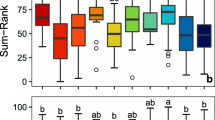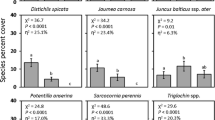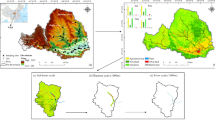Abstract
Various measures of plants, soils, and invertebrates were described for a reference set of tidal coastal wetlands in Southern New England in order to provide a framework for assessing the condition of other similar wetlands in the region. The condition of the ten coastal wetlands with similar hydrology and geomorphology were ranked from least altered to highly altered using a combination of statistical methods and best professional judgment. Variables of plants, soils, and invertebrates were examined separately using principal component analysis to reduce the multidimensional variables to principal component scores. The first principal component scores of each set of variables (i.e., plants, soil, invertebrates) significantly (p < 0.05) correlated with both residential land use and watershed nitrogen (N) loads. Using cumulative frequency diagrams, the first principal component scores of each plant, soil, and invertebrate data set were plotted, and natural breaks and best professional judgment were used to rank the first principal component scores among the sites. We weighted all three ranked components equally and calculated an overall salt marsh condition index by summing the three ranks and then transforming the index to a 0–1 scale. The overall salt marsh condition index for the reference coastal wetland set significantly correlated with the residential land use (R = − 0.87, p = 0.001) and watershed N loads (R = − 0.86, p = 0.001). Overall, condition deteriorated in salt marshes and their associated discharge streams when subjected to increasing watershed residential land use and N loads.
Similar content being viewed by others
References
Able, K. W., Hagan, S. M., & Brown, S. A. (2003). Mechanisms of marsh habitat alteration due to Phragmites: Response of young-of-the-year Mummichog (Fundulus heteroclitus) to treatment for Phragmites removal. Estuaries, 26, 484–494. doi:10.1007/BF02823725.
Anderson, J. R., Hardy, E. E., & Roach, J. T. (1976). A land use and land cover classification system for use with remote sensor data. In Geological survey professional paper 964, a revision of the land use classification system as presented in US geological survey circular (Vol. 671). Washington, DC: United States Government Printing Office.
Barbour, M. T., Gerritsen, J., Snyder, B. D., & Stribling, F. B. (1999). Rapid bioassessment protocols for use in streams and wadeable rivers: Periphyton, benthic macroinvertebrates, and fish (2nd ed.). Washington, D.C.: Office of Water, US Environmental Protection Agency. EPA 841-B-99-002.
Benoit, L. K., & Askins, R. A. (1999). Impact of spread of Phragmites on the distribution of birds in Connecticut tidal marshes. Wetlands, 19, 194–208.
Brawley, A. H., Warren, R. S., & Askins, R. A. (1998). Bird use of restoration and reference marshes within the barn island wildlife management area, Stonington, Connecticut, USA. Environmental Management, 22, 625–633. doi:10.1007/s002679900134.
Brinson, M. M. (1993). A hydrogeomorphic classification for wetlands. Vicksburg: Waterways Experiment Station, US Army Corp of Engineers. Technical report WRP-DE-4.
Brinson, M. M., & Rheinhardt, R. (1996). The role of reference wetlands in functional assessment and mitigation. Ecological Applications, 6, 69–76. doi:10.2307/2269553.
Brooks, R. P., Wardrop, D. H., & Bishop, J. A. (2004). Assessing wetland condition on a watershed basis in the mid-Atlantic region using synoptic land-cover maps. Environmental Monitoring and Assessment, 94, 9–22. doi:10.1023/B:EMAS.0000016876.63062.3d.
Carullo, M., Carlisle, B. K., & Smith, J. P. (2007). A New England rapid assessment method for assessing condition of estuarine marshes: A Boston Harbor, Cape Cod and Islands pilot study. Boston: Massachusetts Office of Coastal Zone Management.
Chintala, M., Wigand, C., & Thursby, G. (2006). Comparison of Geukensia demissa populations in Rhode Island fringe salt marshes with varying nitrogen loads. Marine Ecology Progress Series, 320, 101–108. doi:10.3354/meps320101.
Cole, M. L., Valiela, I., Kroeger, K. D., Fry, B., Tomasky, G. L., Cebrian, J., et al. (2004). Assessment of the isotopic method to indicate anthropogenic eutrophication in coastal lagoons. Journal of Environmental Quality, 33, 124–132.
Collins, J. N., Stein, E. D., Sutula, M., Clark, R., Fetscher, A. E., Grenier, L., et al. (2008). California rapid assessment method (CRAM) for wetlands (ver. 5.0.2, 151 pp.). http://www.cramwetlands.org/documents/2008-09-30_CRAM%205.0.2.pdf.
Darby, F. A., & Turner, R. E. (2008). Effects of eutrophication on salt marsh root and rhizome biomass accumulation. Marine Ecology Progress Series, 363, 63–70. doi:10.3354/meps07423.
Davis, J. L., Nowicki, B., & Wigand, C. (2004). Denitrification in fringing salt marshes of Narragansett Bay, Rhode Island, USA. Wetlands, 24(4), 870–878. doi:10.1672/0277-5212(2004)024[0870:DIFSMO]2.0.CO;2.
Deegan, L. A. (2002). Lessons learned: The effects of nutrient enrichment on the support of nekton by seagrass and salt marsh ecosystems. Estuaries, 25, 727–742. doi:10.1007/BF02804902.
DeLaune, R. D., Nyman, J. A., & Patrick, W. H., Jr. (1994). Peat collapse, ponding and wetland loss in a rapidly submerging coastal marsh. Journal of Coastal Research, 10, 1021–1030.
Donnelly, J. P., & Bertness, M. D. (2001). Rapid shoreward encroachment of salt marsh cordgrass in response to accelerated sea-level rise. Proceedings of the National Academy of Sciences of the United States of America, 98, 14218–14223. doi:10.1073/pnas.251209298.
Evgenidou, A., & Valiela, I. (2002). Response of growth and density of a population of Geukensia demissa to land-derived nitrogen loading, in Waquoit Bay, Massachusetts. Estuarine, Coastal and Shelf Science, 55, 125–138. doi:10.1006/ecss.2001.0891.
Fennessy, M. S., Jacobs, A. D., & Kentuala, M. E. (2007). An evaluation of rapid methods for assessing the ecological condition of wetlands. Wetlands, 27, 543–560. doi:10.1672/0277-5212(2007)27[543:AEORMF]2.0.CO;2.
Findlay, C. S., & Bourdages, J. (2000). Response time of wetland biodiversity to road construction on adjacent lands. Conservation Biology, 14, 86–94. doi:10.1046/j.1523-1739.2000.99086.x.
Findlay, C. S., & Houlahan, J. (1997). Anthropogenic correlates of species richness in southeastern Ontario wetlands. Conservation Biology, 11, 1000–1009. doi:10.1046/j.1523-1739.1997.96144.x.
Findlay, S. E. G., Kiviat, E., Nieder, W. C., & Blair, E. A. (2002). Functional assessment of a reference wetland set as a tool for science, management and restoration. Aquatic Sciences, 64, 107–117. doi:10.1007/s00027-002-8059-8.
Hartig, E. K., Gornitz, V., Kolker, A., Mushacke, F., & Fallon, D. (2002). Anthropogenic and climate-change impacts on salt marshes of Jamaica Bay, New York City. Wetlands, 22, 71–89. doi:10.1672/0277-5212(2002)022[0071:AACCIO]2.0.CO;2.
Hilsenhoff, W. L. (1987). An improved biotic index of organic stream pollution. Great Lakes Entomologist, 20, 31–40.
Holland, A. F., Sanger, D. M., Gawle, C. P., Lerberg, S. B., Santiago, M. S., Riekerk, G. H. M., et al. (2004). Linkages between tidal creek ecosystems and the landscape and demographic attributes of their watersheds. Journal of Experimental Marine Biology and Ecology, 298, 151–178. doi:10.1016/S0022-0981(03)00357-5.
Howes, B. H., Weiskel, P. K., Geohringer, D. D., & Teal, J. M. (1996). Interception of freshwater and nitrogen transport from uplands to coastal waters: The role of saltmarshes. In K. F. Nordstrom & C. T. Roman (Eds.), Estuarine shores: Evolution, environments and human alterations (pp. 287–310). New York: Wiley.
Jacobs, A., McLaughlin, E., & O’Brien, D. L. (2008). Mid-Atlantic tidal wetland rapid assessment method (Ver. 1.0). Delaware Department of natural Resources and Environmental Control, Division of Water Resources.
Jordan, T. E., Andrews, M. P., Szuch, R. P., Whigham, D. F., Weller, D. E., & Jacobs, A. D. (2007). Comparing functional assessments of wetlands to measurements of soil characteristics and nitrogen processing. Wetlands, 27, 479–497. doi:10.1672/0277-5212(2007)27[479:CFAOWT]2.0.CO;2.
Karr, J. R., & Chu, E. W. (1999). Restoring life in running waters: Better biological monitoring. Washington, DC: Island Press.
Kentula, M. E. (2007). Foreword: Monitoring wetlands at the watershed scale. Wetlands, 27, 412–415. doi:10.1672/0277-5212(2007)27[412:FMWATW]2.0.CO;2.
Lerberg, S. B., Holland, A. F., & Sanger, D. M. (2000). Responses of tidal creek macro-benthic communities to the effects of watershed development. Estuaries, 23, 838–853. doi:10.2307/1353001.
Lussier, S. M., DaSilva, S. N., Charpentier, M., Heltshe, J. F., Cormier, S. M., Klemm, D. J., et al. (2008). The influence of suburban land use on habitat and biotic integrity of coastal Rhode Island streams. Environmental Management and Assessment, 139, 119–136. doi:10.1007/s10661-007-9820-1.
Mack, J. J. (2001). Ohio rapid assessment for wetlands v. 5: User’s manual and forms. Ohio Environmental Protection Agency, Division of Surface Water, 401/Wetland Ecology Unit, Columbus, OH, USA. Technical report WET/2001-1. http://www.epa.state.oh.us/dsw/401/.
McKinney, R., Nelson, W. G., Charpentier, M. A., & Wigand, C. (2001). Ribbed mussel nitrogen isotope signatures reflect nitrogen sources in coastal salt marshes. Ecological Applications, 11, 203–214. doi:10.1890/1051-0761(2001)011[0203:RMNISR]2.0.CO;2.
McKinney, R. A., McWilliams, S. R., & Charpentier, M. A. (2006). Waterfowl-habitat associations during winter in an urban eastern North Atlantic estuary. Biological Conservation, 132, 239–249. doi:10.1016/j.biocon.2006.04.002.
Morris, J. T., & Bradley, P. M. (1999). Effects of nutrient loading on the carbon balance of coastal wetland sediments. Limnology and Oceanography, 44, 699–702.
Niering, W. A., & Warren, R. S. (1980). Vegetation patterns and processes in New England salt marshes. Bioscience, 30, 301–307. doi:10.2307/1307853.
Nixon, S. W. (1982). The ecology of New England high salt marshes: A community profile. FFWS/OBS-81/55. Washington, DC: United States Fish and Wildlife Service.
Oviatt, C. A., Nixon, S. W., & Garber, J. (1977). Variation and evaluation of costal salt marshes. Environmental Management, 1, 201–211.
Reinert, S. E., & Mello, M. J. (1995). Avian community structure and habitat use in a southern New England estuary. Wetlands, 15, 9–19.
Rheinhardt, R. D., Brinson, M. M., Christian, R. R., Miller, K. H., & Meyer, G. F. (2007). A reference-based framework for evaluating the ecological condition of stream networks in small watersheds. Wetlands, 27, 524–542. doi:10.1672/0277-5212(2007)27[524:ARFFET]2.0.CO;2.
Roman, C. T., Jaworski, N., Short, F. T., Findlay, S., & Warren, S. (2000). Estuaries of the northeastern United States: Habitat and land use signatures. Estuaries, 23, 743–764. doi:10.2307/1352997.
Rozas, L. P., & Reed, D. (1993). Nekton use of marsh-surface habitats in Louisiana (USA) deltaic salt marshes undergoing submergence. Marine Ecology Progress Series, 96, 147–157. doi:10.3354/meps096147.
Shriver, W. G., Hodgman, T. P., Gibbs, J. P., & Vickery, P. D. (2004). Landscape context influences salt marsh bird diversity and area requirements in New England. Biological Conservation, 119, 545–553. doi:10.1016/j.biocon.2004.01.016.
Smith, R. D., Ammann, A., Bartoldus, C., & Brinson, M. M. (1995). An approach for assessing wetland functions using hydrogeomorphic classification, reference wetlands, and functional indices (p. 90). Vicksburg: US Army Corps of Engineers, Waterways Experiment Station. Wetlands research technical report WRP-DE-9.
Stoll, M. J., & Golet, F. C. (1983). Status of the seaside sparrow in Rhode Island. Audubon Society Report of Rhode Island, 17, 60–61.
Sutula, M., Stein, E. D., Collins, J. N., Fetscher, A. E., & Clark, R. (2006). A practical guide for the development of a wetland assessment method: The California experience. Journal of the American Water Resources Association, 42(1), 157–175. doi:10.1111/j.1752-1688.2006.tb03831.x.
Tober, J., Fritz, C., LaBrecque, E., Behr, P. J., & Valiela, I. (1996). Abundance, biomass, and species richness of fish communities in relation to nitrogen-loading rates of Waquoit Bay estuaries. The Biological Bulletin, 191, 321–322.
Tober, J. D., Griffen, M., & Valiela, I. (2000). Growth and abundance of Fundulus heteroclitus and Menidia menidia in estuaries of Waquoit Bay, Massachusetts exposed to different rates of nitrogen loading. Aquatic Ecology, 34, 299–306. doi:10.1023/A:1009982208382.
Turner, R. E., Swenson, E. M., & Milan, S. S. (2000). Organic and Inorganic contributions to vertical accretion in salt marsh sediments. In M. Weinstein & K. Kreeger (Eds.), Concepts and controversies in tidal marsh ecology (pp. 583–595). The Netherlands: Kluwer.
US EPA (2006). Applications of elements of a state water monitoring and assessment program for wetlands. Office of Water’s Office of Wetlands, Oceans and Watersheds. http://www.epa.gov/owow/wetlands/monitor.
Valiela, I., Collins, G., Kremer, J., Lajtha, K., Geist, M., Seely, B., et al. (1997). Nitrogen loading from coastal watersheds to receiving estuaries: New method and application. Ecological Applications, 7, 358–380. doi:10.1890/1051-0761(1997)007[0358:NLFCWT]2.0.CO;2.
Valiela, I., Geist, M., McClelland, J., & Tomasky, G. (2000a). Nitrogen loading from watersheds to estuaries: Verification of the Waquoit Bay nitrogen loading model. Biogeochemistry, 49, 277–293. doi:10.1023/A:1006345024374.
Valiela, I., Cole, M. L., McClelland, J., Hauxwell, J., Cebrian, J., & Joyce, S. B. (2000b). Role of salt marshes as part of coastal landscapes. In M. Weinstein & K. Kreeger (Eds.), Concepts and controversies in tidal marsh ecology (pp. 23–28). The Netherlands: Kluwer Academic.
Wardrop, D. H., Kentula, M. E., Stevens, D. L., Jensen, S. F., & Brooks, R. P. (2007). Assessment of wetland condition: An example from the Upper Juniata watershed in central Pennsylvania, USQA. Wetlands, 27, 432–445. doi:10.1672/0277-5212(2007)27[432:AOWITU]2.0.CO;2.
Warren, R. S., & Niering, W. A. (1993). Vegetation change on a northeast tidal marsh: Interaction of sea-level rise and marsh accretion. Ecology, 74, 96–103. doi:10.2307/1939504.
Wigand, C. (2008a). Coastal salt marsh community change in Narragansett Bay in response to cultural eutrophication. In A. Desbonett & B. A. Costa-Pierce (Eds.), Science for ecosystem-based management (pp. 499–522). New York: Springer.
Wigand, C. (2008b). Examination of below-ground structure and soil respiration rates of stable and deteriorating salt marshes in Jamaica Bay (NY) (p. 6). The Tidal Exchange, (Newsletter of the New York–New Jersey Harbor Estuary Program). New York: New Jersey Harbor Estuary Program, New York.
Wigand, C., McKinney, R., Chintala, M., Charpentier, M., & Groffman, P. (2004). Denitrification enzyme activity of fringe salt marshes in New England (USA). Journal of Environmental Quality, 33, 1144–1151.
Wigand, C., McKinney, R., Chintala, M., Charpentier, M., & Thursby, G. (2003). Relationships of nitrogen loadings, residential development, and physical characteristics with plant structure in New England salt marshes. Estuaries, 26(6), 1494–1504. doi:10.1007/BF02803658.
Zedler, J. (2005). How compatible are biodiversity and ecosystem service goals? National Wetlands Newsletter, 27, 1.
Author information
Authors and Affiliations
Corresponding author
Rights and permissions
About this article
Cite this article
Wigand, C., McKinney, R., Chintala, M. et al. Development of a reference coastal wetland set in Southern New England (USA). Environ Monit Assess 161, 583–598 (2010). https://doi.org/10.1007/s10661-009-0770-7
Received:
Accepted:
Published:
Issue Date:
DOI: https://doi.org/10.1007/s10661-009-0770-7




